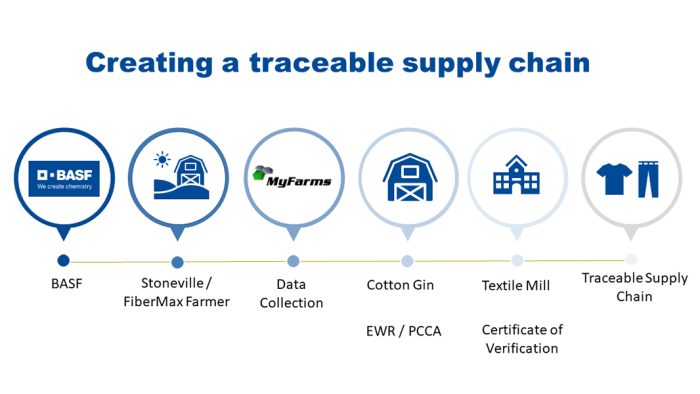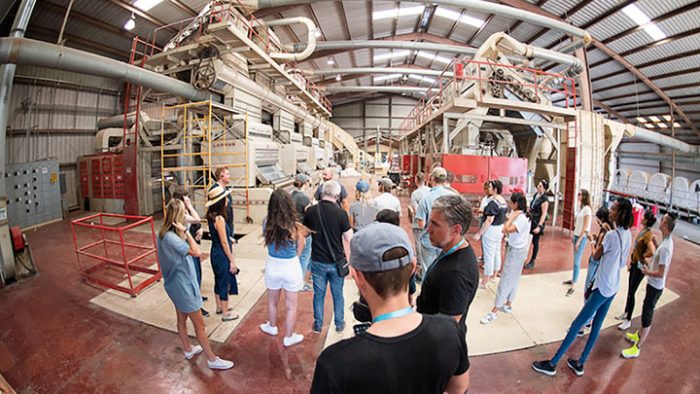BASF’s e3 Sustainable Cotton program is designed to directly connect members of the cotton fiber value chain, from cotton farmers to brands to retailers. e3 stands for equitable, economically viable and environmentally responsible, as BASF is aiming to align itself with a consumer base that is increasingly eco-conscious and is demanding traceability in the clothes they buy to verify they are in synch with their mindset from a sustainability perspective.
The program is based on BASF’s certified FiberMax cotton and authentic Stoneville cotton seed that can be traced from the farmer to the gin and right through to the merchant, mills and retailers. In this way, the e3 Sustainable Cotton program allows end customers to know exactly what their clothes are made of, how they are made, and where the cotton comes from.
For cotton farmers to participate in the e3 program, they must register with BASF and commit to grow cotton more efficiently, decreasing the impact to the environment. Their cotton is certified and verified through independent audits, allowing BASF to track specific environmental and social measures to an individual farmer.
According to BASF, the e3 Sustainable Cotton program is the only cotton supply that tracks environmental outcomes back to each cotton field, as well as the only conventional cotton supply that can deliver item-level sustainability promises.
Through BASF’s digital platform, MyFarms, e3 Sustainable Cotton information is converted using tools managed by independent scientists into multiple different sustainability measures, including: Irrigation Water Use and Water Quality, Pesticide Management & Usage, Soil Conservation & Fertility Management, Greenhouse Gas Emissions, Energy Use & Conservation, Worker Health & Safety, Identity Preservation, and Soil Carbon.
In December 2021, BASF hosted a virtual event to showcase the e3 program, featuring presentations from several U.S. cotton farmers, cotton mills and apparel manufacturers who participate in the e3 program. The event was moderated by Jennifer Crumpler, BASF’s fiber development manager and manager of the e3 Sustainable Cotton program. IFJ was in attendance, and we followed up with Jennifer after the event to gain some more perspective on the history and evolution of the e3 program. The outcome of this conversation is the Executive Q&A for this edition of IFJ.
Matt Migliore: How did the e3 Sustainable Cotton initiative come to be, and why do you feel it is a necessary program for the cotton industry today?
Jennifer Crumpler: The e3 Sustainable Cotton program by BASF was born in 2013 to meet the needs of two important audiences. First, cotton farmers, whose interests were piquing around on-farm sustainable practices. And second, consumers, who were enthusiastically embracing the farm-to-table movement in the food industry and wondering why their textile brands weren’t being as transparent regarding their supply chains.
At this time, consumers were asking tough questions about where their clothes were coming from, how they were made, and how this affected the environment. And they weren’t always happy with answers they were given — if they were even given an answer.
As retailers scrambled to address these consumer concerns, they found a huge disconnect in every part of their supply chain and, essentially, not enough data to provide what consumers demanded — transparency.
This is what helped the e3 Sustainable Cotton program take off. BASF’s unique position in the supply chain enables brands to deliver on these demands with the only sustainable cotton program that is truly engrained at the farmer level. The program works by tracking environmental outcomes back to each farmer’s individual cotton field and even to each bale of cotton.

Matt Migliore: What can you say about the pillars of the e3 program – socially equitable, economically viable and environmentally responsible – and why each are important to the U.S. cotton supply chain?
Jennifer Crumpler: These three pillars are not only part of our name, but they’re ingrained in the e3 Sustainable Cotton mission to create a better world and redefine the cotton fiber value chain.
This program originated from meeting the needs of two different audiences, farmers and consumers, so it was important for the e3 Cotton program to be socially equitable for everyone involved.
Our vision for honest, fair and sustainable cotton isn’t possible without dedicated farmers, which is why we had to make this program economically viable for them. Not only do our farmers receive a $2.50 premium for each bale they submit to our program, but we also created the e3 Grower Fund last year to further support them. Cotton fiber value chain partners can contribute a monetary amount at their discretion to the fund. At the end of each year, 100 percent of those funds are distributed equally to e3 Sustainable Cotton farmers.
Growing environmentally responsible cotton is key to our program and we differentiate ourselves in that we have our farmers track eight specific on-farm environmental and social measures: irrigation water use and water quality; pesticide management and usage soil conservation and fertility management; greenhouse gas emissions; energy use and conservation; worker health and safety; identity preservation and soil carbon. These sustainability measures are helping farmers reduce soil erosion, save water and lower cotton’s carbon footprint.
When more brands feel the pressure to increase their standards and begin implementing better stewardship practices, I think we’ll begin to see a positive shift in the U.S. cotton supply chain. Doing the right thing isn’t always the easiest thing, but we know programs like ours are the future of the cotton industry.
Matt Migliore: What can and/or could be done to help the U.S. cotton supply chain more effectively compete, while adhering to the social and environmental pillars of the e3 program, in a global marketplace where very low wage labor and a lack of true environmental commitment are an unfortunate reality of the competitive landscape?
Jennifer Crumpler: Consumers are demanding more transparency from brands. They are asking thoughtful questions and using that information to make more conscious purchasing decisions. When more brands feel the pressure to increase their standards and begin implementing better stewardship practices, I think we’ll begin to see a positive shift in the U.S. cotton supply chain. Doing the right thing isn’t always the easiest thing, but we know programs like ours are the future of the cotton industry.
Matt Migliore: What makes traceability such a challenging aspect of the cotton supply chain and why is it growing in importance in today’s marketplace? How does the e3 program help overcome this challenge?
Jennifer Crumpler: The traceability issue is one of the reasons the e3 Sustainable Cotton program exists. For so long the cotton supply chain has been operating in a silo. Parts of the supply chain weren’t communicating, and retailers were having disconnects in their supply chains and had no clue how to solve them.
The e3 Sustainable Cotton program came in and reimagined the way the cotton supply chain should operate. We truly believe in data and see the value in educating all parts of the supply chain.
The e3 Cotton program is successful and one-of-a-kind because we are driven by that data. We use a third-party online farm management platform called MyFarms to track eight specific on-farm environmental and social measures. Once the cotton is grown and sent to the gin, permanent bale ID numbers are assigned, creating traceability from farm to end use. It’s truly a seed to jean story.
And thankfully we have the data to answer consumers questions. If they are buying a pair of jeans, they deserve to know where that cotton was grown, how much water was used to grow it, where it was cleaned – truly every step of its journey.
Matt Migliore: From a consumer perspective, are you seeing an evolution in the buying habits of today’s consumers where they are willing to pay a premium for U.S.-made and/or environmentally conscious products?
Jennifer Crumpler: I read in a November 2021 Forbes article that almost half of U.S. online consumers regularly buy from brands or companies that align with their personal values and that environmental impact is top of mind for those consumers.
Consumers are asking questions and demanding answers, so that’s a positive. I think there’s still a lot of greenwashing happening in the marketplace. Brands are using buzz words like “sustainable” and “less water used” or “organic” and many consumers are putting their trust in those brands. I think more education is needed. Once consumers begin to understand why U.S. made or environmentally conscious products are more expensive, then we’ll see a shift in their buying habits. They aren’t just paying for well-made jeans, but they are also paying for environmental benefits, locally sourced materials, and competitive wages for workers.

Matt Migliore: What makes e3 Sustainable Cotton advantageous from an environmental perspective?
Jennifer Crumpler: The e3 Sustainable Cotton program leads with data. There are other sustainable cotton programs out there, but they are not capturing and sharing data in the same manner.
The eight sustainability measures we track help farmers reduce soil erosion, save water and lower cotton’s carbon footprint.
Last year we saw 43% implement reduced tillage practices. Reduced tillage is the practice of minimizing how much a farmer turns over the soil each year. This helps keep soil healthy. Not only does it keep soil from moving, but it also requires fewer machinery trips through fields – reducing greenhouse gas (GHG) emissions, too.
We also saw 63% of farmers incorporate practices that build carbon through their production system. Practices like crop rotation, reduced tillage and cover crops build carbon in the soil, improving soil quality. By storing carbon in the soil, it also limits carbon loss to our atmosphere, reducing climate impacts from cotton production.
And last year 34% used a simple crop rotation on half their ground, while 15 percent used a complex rotation. By rotating crops – either two different crops or multiple different crops – farmers can naturally replenish important nutrients in the soil, like nitrogen, and potentially reduce how much they rely on chemical inputs.
In addition, we also provide brands and mills with an e3 purchasing impact report. This allows them to see the environmental impact they had just by purchasing e3 cotton.
Matt Migliore: What makes e3 Sustainable Cotton different than conventional cotton?
Jennifer Crumpler: As a farmer, when you agree to enroll in the e3 Sustainable Cotton program, you’re agreeing to adhere by our eight sustainability measures. This means that consumers can feel good about purchasing products made with e3 Sustainable Cotton versus other cotton because they know the entire story. They know our farmers and supply chain partners are committed to growing sustainable cotton and to provide the transparency that consumers want.
Matt Migliore: How is e3 cotton different than USDA organic cotton?
Jennifer Crumpler: The e3 Sustainable Cotton program offers growers a choice for enrolling the cotton they grow on their farm. Many of our farmers are very diversified in the cotton that they grow and the production practices they utilize on their farm, so many growers are growing some organic cotton, and some conventional cotton on the same operation, so with e3 we have helped create a market for all the cotton a grower farms.
Matt Migliore: Looking 5-10 years into the future, how do you see the U.S. cotton supply chain evolving to more effectively balance the environmental, social and economic expectations of consumers?
Jennifer Crumpler: The pandemic and other factors have really exasperated issues within the cotton supply chain and cotton industry. Issues that have been long neglected; we’re now having to respond to quickly. Transparency and traceability will be a requirement moving forward, as well as being able to provide data for sustainability claims, not just with the raw cotton going into products, but throughout the supply chain. I think that U.S. farms are leading the way, and I am excited that BASF, through our e3 program, is a leader. In 2019 to 2020, we had a 40% increase in the number of growers enrolled in our program and from all 17 cotton growing states. We don’t see this being a “fast fashion” trend, but one that is here to stay, and as the digital space continues to grow, this demand will continue to increase.
At BASF, we have committed to have over 400+million hectares supported by digital technology by 2030.
Matt Migliore: Is there anything about the e3 Sustainable Cotton program and/or sustainability in general that we haven’t touched upon here that you feel is important for our readers to know?
Jennifer Crumpler: The e3 Sustainable Cotton program mission from day one has been to create an entirely traceable, transparent, sustainable cotton supply. We encourage consumers to continue to ask questions and demand more from the brands they love.
For more information on the BASF e3 Sustainable Cotton program, visit agriculture.basf.us/crop-protection/e3-cotton.html.


